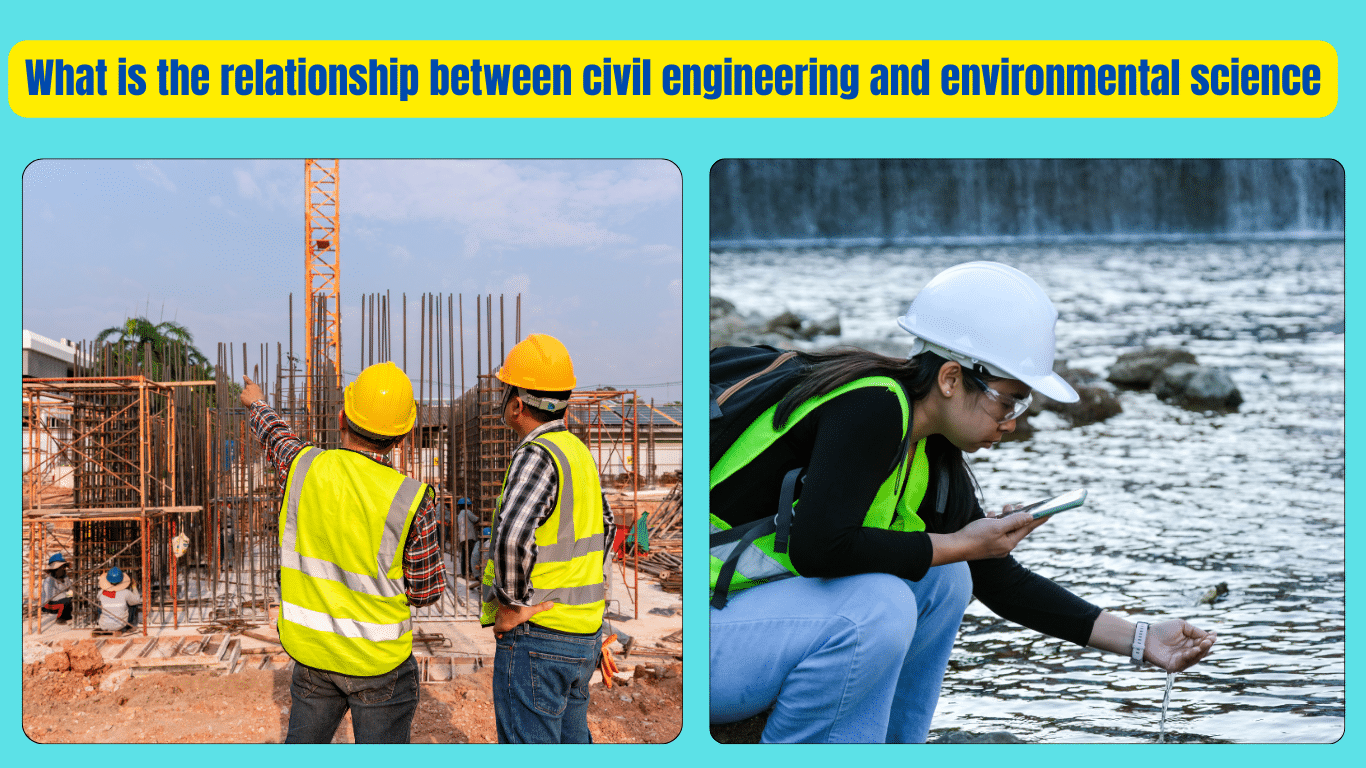There is a deep relationship between civil engineering and environmental science in various ways. Civil engineering primarily deals with designing, constructing, and maintaining infrastructure such as buildings, bridges, roads, and dams. On the other hand, environmental science focuses on understanding the natural environment and how human activities impact it. The relationship between these two fields arises from the fact that civil engineering projects can significantly affect the environment. Environmental science helps civil engineers assess the environmental impact of their projects and develop strategies to minimize harm to ecosystems and communities.
For instance, environmental scientists might conduct assessments to determine the potential effects of a new construction project on air and water quality, wildlife habitats, and overall ecosystem health. Civil engineers can then use this information to implement measures that mitigate negative impacts and promote sustainable development. By integrating principles from both civil engineering and environmental science, professionals can work together to create infrastructure that meets human needs while preserving and protecting the natural world for future generations.
Understanding the relationship between civil engineering and environmental science
In the huge land of engineering and science, two disciplines stand out for their critical roles in shaping our world: civil engineering and environmental science. While they may seem distinct at first glance, these fields share a deep and intricate relationship that is essential for creating sustainable infrastructure and protecting our environment. Let’s delve into this relationship, exploring how civil engineering and environmental science intersect and collaborate to address the challenges of our modern world.
The Basics: What is Civil Engineering?
Civil engineering is a branch of engineering that deals with the design, construction, and maintenance of infrastructure projects essential for human civilization. From skyscrapers to bridges, roads to dams, civil engineers are responsible for creating structures that facilitate human activities and improve quality of life. They apply principles of physics, mathematics, and materials science to solve complex problems and ensure the safety, functionality, and durability of their creations.
Environmental Science: Understanding Nature’s Balance
On the other hand, environmental science focuses on studying the natural world and the interactions between living organisms and their environment. It encompasses various disciplines, such as ecology, biology, chemistry, and geology, to analyze environmental issues, monitor ecosystems, and develop strategies for conservation and sustainability. Environmental scientists strive to understand how human activities impact the environment and work towards mitigating negative effects while promoting harmony between nature and society.
Where the Two Worlds Collide: The Intersection of Civil Engineering and Environmental Science
The relationship between civil engineering and environmental science arises from the undeniable fact that human infrastructure projects can have significant impacts on the environment. Whether it’s constructing a new highway, building a high-rise apartment complex, or developing a water supply system, every civil engineering endeavor interacts with the natural world in some way. This interaction can result in alterations to ecosystems, changes in air and water quality, habitat destruction, and other environmental consequences.
Assessing Environmental Impact: The Role of Environmental Science
Environmental scientists play a crucial role in civil engineering projects by assessing their potential environmental impacts. Before any construction begins, environmental impact assessments (EIAs) are conducted to evaluate the project’s effects on the surrounding environment. This involves studying factors such as air and water quality, soil composition, biodiversity, and the presence of endangered species.
Through field surveys, data collection, and computer modeling, environmental scientists identify potential risks and develop strategies to mitigate them. They may propose alternative designs, construction methods, or site locations to minimize harm to sensitive ecosystems. By integrating environmental considerations into the planning phase of civil engineering projects, environmental scientists help ensure that development is sustainable and environmentally responsible.
Mitigating Environmental Risks: Strategies for Sustainability
Once a project is underway, civil engineers work closely with environmental scientists to implement measures that minimize environmental impact. This may involve using environmentally friendly materials, incorporating green infrastructure such as permeable pavement or green roofs, and implementing erosion control and stormwater management systems.
For example, in the construction of a new bridge, civil engineers may work with environmental scientists to minimize disruption to aquatic habitats by implementing temporary fish migration barriers or employing construction techniques that reduce sediment runoff into nearby waterways. By collaborating on these strategies, civil engineers and environmental scientists can mitigate environmental risks while still achieving project objectives.
Promoting Sustainable Development: The Way Forward
In an era where environmental sustainability is paramount, the relationship between civil engineering and environmental science is more critical than ever. Together, these disciplines hold the key to promoting sustainable development practices that meet the needs of society while protecting our planet’s precious natural resources.
By integrating principles of environmental science into civil engineering education and practice, future generations of engineers will be equipped with the knowledge and skills necessary to address the complex challenges of our changing world. Collaboration between civil engineers and environmental scientists will continue to drive innovation and lead to the development of infrastructure that is resilient, efficient, and environmentally responsible.
Some Key Points: What is the relationship between civil engineering and environmental science?
Understanding the Relationship Between Environment and Engineering
The relationship between the environment and engineering is deeply intertwined. Engineering, in its various forms, interacts with the environment in numerous ways. Whether it’s constructing buildings, roads, bridges, or developing infrastructure for energy production and transportation, engineering activities can have significant impacts on the environment. Conversely, the environment also influences engineering endeavors, shaping design considerations and engineering solutions to address environmental challenges.
importance of Environmental Studies in Civil Engineering
Environmental studies play a crucial role in civil engineering for several reasons. Firstly, understanding the environment is essential for assessing the potential impacts of engineering projects. Civil engineers need to evaluate how their designs will affect ecosystems, air and water quality, biodiversity, and overall environmental health. Secondly, environmental studies provide valuable insights into sustainable practices and technologies that can minimize environmental harm and promote long-term sustainability in civil engineering projects.
The Role of Civil Engineers in Environmental Protection
Civil engineers play a vital role in protecting the environment through their work. They are responsible for designing and implementing infrastructure projects that minimize negative impacts on the environment while meeting the needs of society. This involves integrating environmental considerations into all stages of a project, from planning and design to construction and maintenance. Civil engineers strive to develop innovative solutions that balance human development with environmental conservation, ensuring that infrastructure projects are both functional and environmentally responsible.
Understanding the Relationship Between Environmental Science and Engineering
Environmental science and engineering are closely related fields that intersect in many ways. While environmental science focuses on understanding the natural environment and its processes, environmental engineering applies scientific principles to develop solutions for environmental challenges. Civil engineering often incorporates aspects of both disciplines, especially concerning environmental impact assessments, pollution control, and sustainable design practices. Therefore, environmental science provides the foundational knowledge that informs engineering approaches to environmental issues.
Environmental Engineering: A Subset of Civil Engineering
Environmental engineering is indeed a part of civil engineering, but it is also a distinct discipline in its own right. While civil engineering encompasses a broad range of infrastructure projects, including buildings, transportation systems, and water resources management, environmental engineering specifically focuses on addressing environmental challenges such as pollution control, waste management, and environmental remediation. Civil engineers can specialize in environmental engineering through additional education and training focused on environmental principles and practices.
Civil Engineering’s Role in Environmental Pollution Control
Civil engineering plays a crucial role in controlling environmental pollution through various means. Engineers develop and implement technologies for treating wastewater and solid waste, reducing air emissions from industrial processes and vehicles, and remediating contaminated sites. Additionally, civil engineers design infrastructure systems, such as stormwater management facilities and green infrastructure, that help prevent pollution and protect natural ecosystems. By incorporating pollution control measures into their projects, civil engineers contribute to preserving environmental quality and public health.
The relationship between civil engineering and environmental science
A civil engineer can transition to becoming an environmental engineer by gaining additional education, training, and experience in environmental engineering principles and practices. This may involve pursuing advanced degrees or certifications in environmental engineering, participating in professional development opportunities focused on environmental topics, and gaining hands-on experience working on environmental projects. By expanding their expertise in environmental science and engineering, civil engineers can effectively contribute to addressing environmental challenges and promoting sustainable development.
Conclusion
In conclusion, the relationship between civil engineering and environmental science is symbiotic and essential for creating a sustainable future. By working together, civil engineers and environmental scientists can design infrastructure that meets human needs while minimizing environmental impact. Through careful planning, assessment, and implementation, they can pave the way for a world where development coexists harmoniously with nature. It is through this collaboration that we can build a better tomorrow for generations to come.
FAQs
What is the relationship between civil engineering and environmental science?
The relationship between civil engineering and environmental science is that civil engineering projects can affect the environment, and environmental science helps assess and mitigate those impacts.
How do civil engineers consider the environment in their projects?
Civil engineers consider the environment by assessing potential impacts like air and water quality changes, habitat disruption, and soil erosion caused by construction activities.
Why is environmental assessment important in civil engineering?
Environmental assessment in civil engineering is essential to understand and minimize the negative effects of projects on ecosystems, wildlife, and overall environmental health.
What are some examples of environmental considerations in civil engineering projects?
Examples include using eco-friendly materials, designing sustainable drainage systems, and preserving natural habitats during construction.
Is environmental science part of civil engineering education?
Environmental science concepts are often included in civil engineering education to help students understand the environmental implications of their projects.
How do civil engineers collaborate with environmental scientists?
Civil engineers collaborate with environmental scientists to conduct environmental impact assessments, develop mitigation strategies, and ensure projects comply with environmental regulations.
What role do civil engineers play in environmental protection?
Civil engineers play a vital role in protecting the environment by designing and implementing infrastructure projects that minimize pollution, conserve resources, and promote sustainability.
Are there specific laws and regulations that govern the environmental aspects of civil engineering projects?
Yes, there are laws like the Clean Water Act and regulations set by environmental agencies that civil engineers must follow to protect the environment during project planning, design, and construction.
How can civil engineering contribute to environmental conservation efforts?
Civil engineering can contribute to environmental conservation by designing projects that enhance ecosystem resilience, promote renewable energy sources, and reduce carbon emissions.
Can civil engineering and environmental science collaboration lead to innovative solutions for environmental challenges?
Yes, collaboration between civil engineering and environmental science can lead to innovative solutions such as green infrastructure, sustainable transportation systems, and eco-friendly construction techniques to address environmental challenges effectively.





